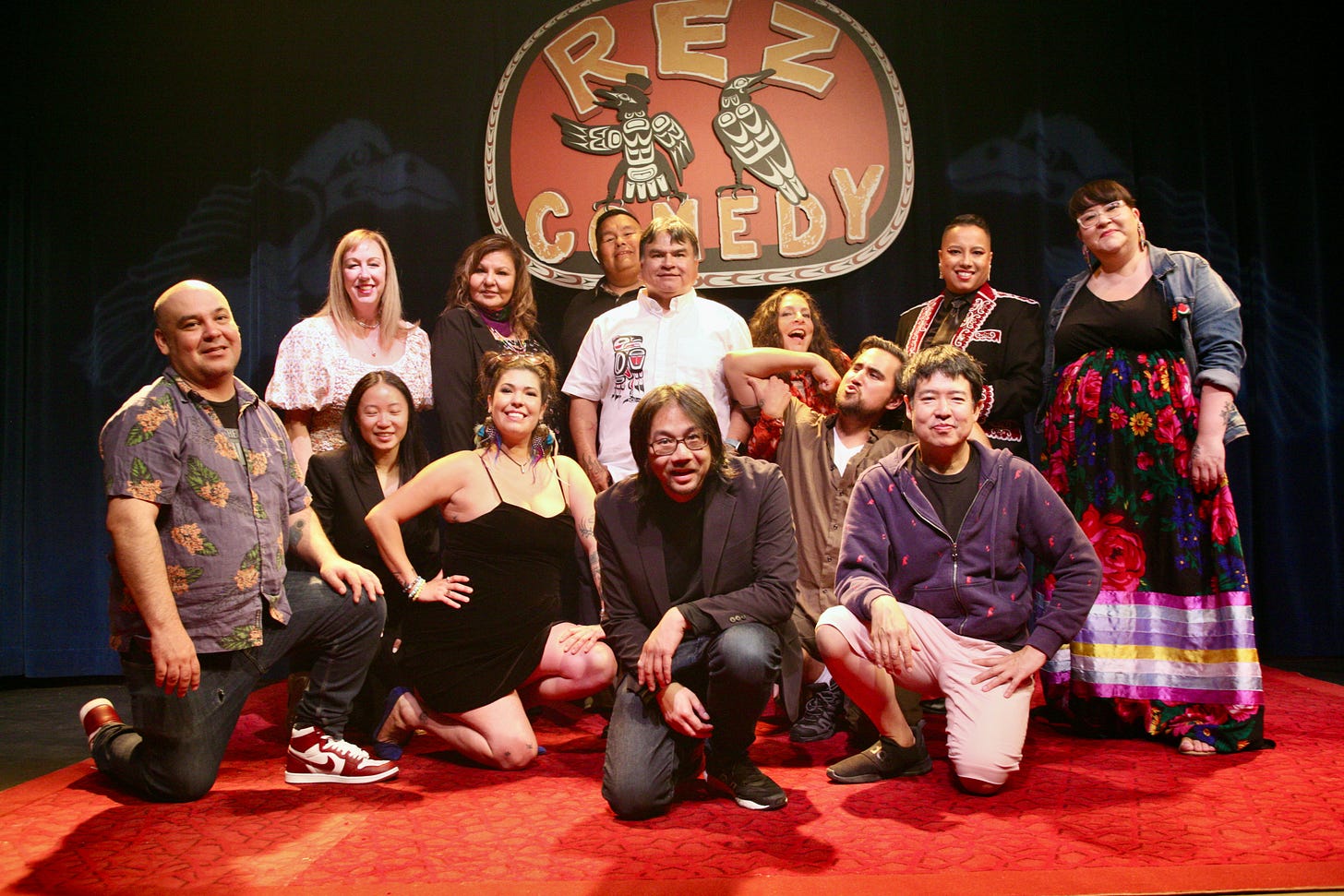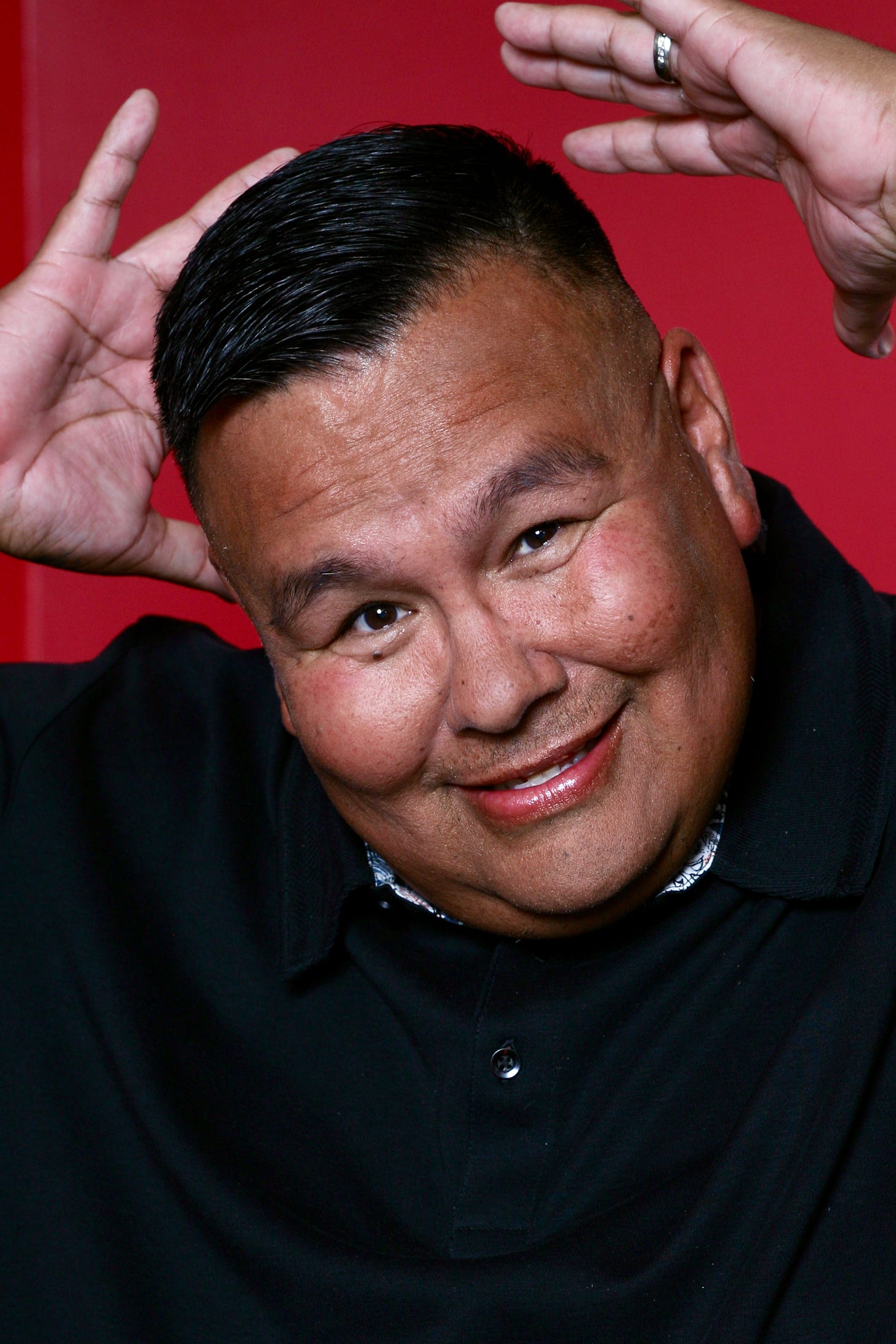A good comedy film doesn't necessarily have to rely on getting the laugh every time. Ghostbusters, for example, is endlessly rewatchable, but audacious twists like the marshmallow man reveal and the ghost blowjob are really only gonna generate that big WTF shock laugh the first time. There's a craft to making a good comedy, like any other kind of movie, and it's not just about good jokes.
For a stand-up comedy movie, however, the jokes are it. They either make you laugh or they don't. And if they don't, that's pretty much the whole ballgame (with some exceptions). I laughed out loud maybe twice during Rez Comedy, a filmed comedy show featuring a lineup of all Canadian Indigenous comics. Once when Chuck Cease, who jokes about drunkenness and diabetes and says “fuckin'” a lot, suggested that a white guy who negatively stereotyped him must be psychic. The second time was when nonbinary Janelle Niles explained her use of “her” pronouns by explaining that her male side was an asshole, and also wanted her to keep her female parts so he could touch them constantly
My main WTF moment came at the end of the credits when a disclaimer came up that the movie is a work of fiction. So we didn't just watch a comedy show? It never happened? I get that it's legalese, but it doesn't make sense in context.
For a lot of Gen-Xers, the thought of Native American stand-up probably recalls the South Park casino episode, in which stereotypically stoic Indians make jokes about a pony with a sore throat being a little horse, as the audience rhythmically chants “HA ha-ha-ha, HA ha-ha-ha.” It's funny because it's such a dumb stereotype, with Trey Parker and Matt Stone as usual making no attempt to realistically depict a culture, but portray it the way a stupid person imagines it. (We might agree to disagree, but that's where I find the funny in it.)
That said, for most of Rez Comedy, I found myself wishing for a joke as witty as the one about a pony being a little hoarse. A routine by Brenda Prince about giving sex positions new Indian names felt no less stereotypical, though Helena Paul referring to the clitoris as “the little lady in the canoe” is somewhat inspired.
Emcee Keith Nahanee opens the movie with a vignette about difficult chores in his youth, the large extended families many First Nations people have, and the amount of death they see as a result. Comedy, he notes, comes from pain, as a way to deal with it. He's right, of course – many funny people are deeply depressed, and the root of most humor is human failing. Yet you can't just put a person in pain on stage and expect them to be an insta-comedian; stagecraft requires a certain level of confidence. Sadly, most of the folks here don't have it. I can feel their pain, and definitely their insecurity – two of the female comics nervously laugh after every line they utter, but in one case, it feels like a half-hearted part of an act that isn't quite a character yet, and in another it feels almost entirely subconscious and involuntary.
Each comic gets a brief vignette before they go onstage, to tell us what their comedy is about; most nervously offer some variation of “It's about my life.” Kevin Shawanda confidently exclaims he's going to tell us some of the darkest, sickest jokes we've ever heard, and proceeds to make obvious quips about smallpox blankets before telling a gross-out story (about finger-banging white women and licking up semen) that's trying too hard.
I'm going to assume some cultural disconnect is in play, as frequent references to “Urban Indian” and “City Native” seem to be punchlines in and of themselves, in a way that seems to me to need more, but may be an inherently funny concept if it's one talked about a lot in your life. Nor do I know what Bannick bannock is, though it seems to get laughs.
In many cases, though, it feels like these people simply haven't seen much stand-up before. Jokes about sex being different in real life than on TV, or explanations of what the taint is on a man are cliché, and just how old a tagline is “tastes great, less filling”? Nahanee at one point makes a joke about Kevin Costner characters, and when nobody laughs, proceeds to explain the joke, which, if you have to do that, well, you know.
At least the stage is appealing. With a black backdrop and colorful carpet and signage, it feels like a welcoming space in the same way that cartoons are inherently welcoming visuals to kids. It beats the cliched brick wall or red curtain we've become accustomed to, and codirectors Nahanee and Quentin Lee do everything they can to make things – and people -- look good. What they can't do is rewrite the material, though somebody should have.
It's impossible to recommend the movie for laughs, though if it has lasting value, it may be as a cultural moment in time. Study what it is that doesn't work here, and you'll find layers of generational trauma not easily converted into punchlines. Shawanda gets closest, but tends to belabor the joke, as with a bit about moving to a house on a white people burial ground, “so now great stuff happens!” That's a good line, but then he goes on to joke about every white person ghost and it becomes a standard “White people say this...” bit. It's mainly funny when Black comics do it because they impersonate what a nasal, uptight white person sounds and looks like to them; merely listing off the cliches in a “ghost” voice just over-extends the bit past funny.
Comedy desperately needs diversity in this era of punching down and aging-out has-beens whose specials are always called, like, “Canceled!” or “Trigger Warning!” I wish I had found that Rez Comedy was the antidote, but it needs work, and maybe some acting classes from its participants to project confidence in their material in addition to actually making it funny. A psychologist might have a field day with this movie; a comedy fan, not so much.
Rez Comedy premieres on SVOD on AAM.tv and TVOD on Amazon Prime on Friday, February 14. All images courtesy of mPRm./margin films/rez comedy








“the little lady in the canoe”
ummmmmm......
i don't get it
(that's the joke)
It might be Bannock they were talking about and not Bannick. It's a kind of bread and a county here in Idaho named after the Bannock tribe.
https://en.wikipedia.org/wiki/Bannock_(Indigenous_American_food)
https://en.wikipedia.org/wiki/Bannock_County,_Idaho